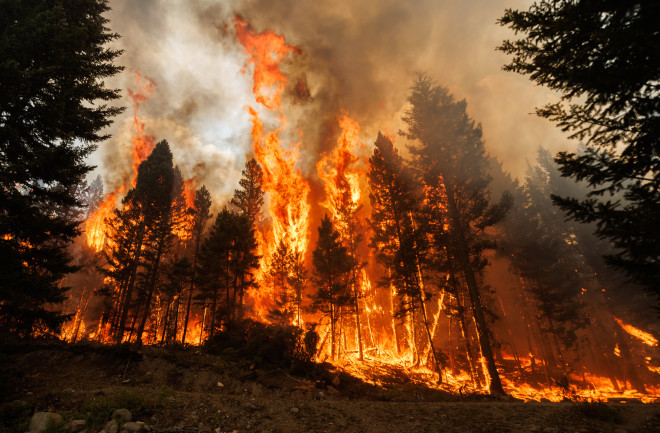While temperatures in Phoenix soared above 110 degrees Fahrenheit for a record-shattering 31 straight days in July, people began turning up in emergency rooms with third-degree burns they’d suffered after falling — their skin seared by blistering hot pavement. Although not unprecedented, burn specialists said the number and severity of injuries were much higher than ever before.
Meanwhile, 30,000 feet up, the jet stream had become deranged. Its wavy, loopy and swirling pattern helped lock heat domes in place, like the one over south-central Arizona. Meteorologist Jeff Berardelli called the pattern “insane.” University of Pennsylvania climate scientist Michael Mann likened it to a Vincent Van Gogh painting.
What Is Global Weirding?
In Canada, by midsummer, wildfire season was already twice as bad as any other on record, thanks to abnormally warm and dry conditions. By early September, 63,700 square miles had burned — about half the size of South Carolina. Far-flung smoke from the blazes choked millions in major cities like New York and turned skies a sickening shade of orange.
Elsewhere in the world, parts of India saw particularly heavy monsoon deluges that inundated several cities for days. Over the past seven decades, the monsoon has become more erratic, with more extreme rainfall as well as sudden droughts, at least partially tied to warming Indian Ocean waters.
Back in the early 2000s, author and environmentalist L. Hunter Lovins coined the term “global weirding” as an alternative to “global warming.” The idea was to describe where Earth was heading with continued emissions of greenhouse gases. The weather extremes of 2023 suggest she was prescient.
“I do think there’s something to the ‘global weirding’ framing,” says Mann. “We’re experiencing a type of weather behavior we haven’t seen before.” Research by Mann and colleagues has tied certain behaviors — like stalled weather systems floating over a place for weeks on end — to a jet stream flow made wavier than normal by climate change. But that possible connection is still the focus of intense scientific study.
How Hot Is the Planet Getting?
While some of the detailed mechanisms are still being worked out, there’s no doubt humans have been tilting the climatic scales toward more intense and frequent extreme weather. In addition to hotter and longer-lasting heat waves, that includes drier droughts (with both hot and dry conditions contributing to wildfire disasters), as well as heavier deluges.
In 2023, our hand seemed to push even more heavily on the scales. On July 6, for example, Earth’s average surface temperature soared to an unofficial record high. It could well have been the warmest day in 120,000 years. Research has shown that heat waves in Southern Europe, North America, and China were made 1.8 F to 4.5 F hotter by climate change. Moreover, the maximum heat experienced in some of these regions would have been all but impossible without our influence.
With broiling heat still gripping large parts of the planet, scientists knew well before the end of July that the month would be the warmest on record. This prompted U.N. Secretary-General António Guterres to say, “The era of global warming has ended; the era of global boiling has arrived.”
Outside of the polar oceans, April’s average global sea surface temperature had vaulted to a record-high seasonal value, and sea temperatures continued shattering records every day through September. A burgeoning El Niño — characterized by large amounts of oceanic heat surfacing in the equatorial Pacific — contributed to the sweltering surface waters. But that couldn’t explain all of what was happening.
The current El Niño is building on top of long-term, human-caused warming of the oceans. Thanks to both, 2023 is likely to go down in the record books as the warmest year ever observed. And 2024 could be warmer still, with weather becoming even more extreme.
This story was originally published in our January February 2024 issue. Click here to subscribe to read more stories like this one.

